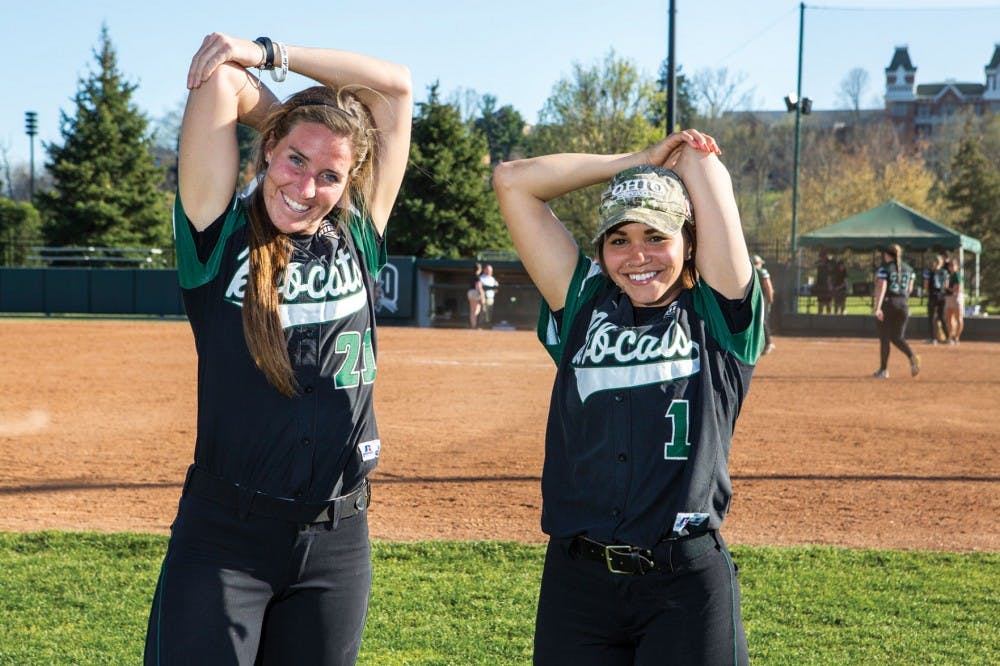Almost all of Ohio's out-of-state players are from perennial warm weather states where the game can be played all year long, but that isn't always a good thing.
On the first day of outdoor practice, Ohio outfielder Sloan Walker had her ideal gameday weather: 70 degrees with a few clouds in the sky to block the sun from her eyes.
Being from Cypress, Texas, Walker was used to playing in the intense heat before she came to Ohio in 2013.
"We always had ambulances there because people would drop from the heat all the time," Walker said. "The worst part was when we would have a rain delay, and then you would come back and there would literally be steam coming from the grass."
Four of the six out-of-state Ohio players are from "warm-weather states," where softball can be played outdoors year-round.
According to The Enterprise News in Brockton, Massachusetts, teams that play in warm weather states tend to have an advantage due to the consistent weather.
"(Warm weather states) have traditionally been areas where the recruiting has been more dominant," Ohio coach Jodi Hermanek said. "Those states are very competitive with their summer ball teams as well as their high school teams."
Hermanek said states without weather advantages can catch up by building indoor practice facilities, though that isn't the same as playing on dirt and real grass every day.
Ohio, typically considered a colder state due to its frigid winters and temperate spring and summer seasons, has led the Bobcats to catch up with year-round practicing through utilizing Walter Fieldhouse.
Walker said it can be frustrating taking fly ball practices to Walter because fly balls hit the roof, and the turf is much bouncier than real grass — not emulating a real game-time experience.
Though playing softball or baseball outdoors year-round could be great, there is greater risk for potential injury if players are found on the field too much.
Across baseball and softball youth leagues, there is a growing concern that players are playing too much of the sport. Some parents and spectators believe the "travel ball culture", where Little League baseball players participate year-round, could be a main cause of the increase in arm injuries among younger players.
A study conducted by researchers at the Mayo Clinic in Rochester, Minnesota, and the Kerlan-Jobe Orthopedic Clinic in Los Angeles collected data on a random sample of 100 uninjured male high school baseball pitchers between 14- and 18-years-old. The study concluded that children who use their arms more are at higher risk of injury.
And the warmer the weather, the more opportunities there are to throw.
Softball pitchers typically experience significantly fewer shoulder issues than their baseball counterparts, partially due to the fact that they throw differently. The study, however, says the overuse of the shoulder is what separates the warm from the cold weather players.
What the study doesn't show is that softball pitchers use their arms more often than baseball pitchers on shorter rest. For example, Ohio ace Savannah Jo Dorsey threw 15 and 1/3 innings in a three-game series against Western Michigan, and Hermanek said the workload was "perfectly normal."
In comparison, Ohio pitcher Gerry Salisbury has pitched 25 innings in 10 appearances this season.
"It's a little bit tiring towards the end, but we work for that," Dorsey said after a similarly-large workload in a doubleheader against Kentucky in March. Dorsey said Hermanek works with her on her endurance in practice to enable her to pitch as often as she does.
{{tncms-asset app="editorial" id="80c399fe-04b4-11e6-9414-6b8d538c8374"}}
Dorsey may pitch more often than baseball pitchers, but she uses her arms in different ways more consistently.
"The rotation of the arm path is a lot different," Hermanek said. "In softball, it is a lot easier on the shoulder, rotator cuff, and muscles. It's the pitchers that don't use their legs enough that come to injuries because they are putting a lot of pressure on their wrist, bicep or forearm."
Hermanek doesn't believe Dorsey's heavier workload will lead her to injury.
"We're finding that there are a lot of specific injuries to playing a lot of softball constantly," Hermanek said. "Those joints, those muscles, they need a break. So if you go do something different, mentally it's great for you as a competitor, but physically it's great for your joints that throw softballs all the time to take a break."
Besides that, Hermanek said she prefers to have more well-rounded athletes on her team — a split from the rising interest in having athletes play one sport year-round.
"We want to recruit athletes," Hermanek said. "People who play multiple sports are great athletes. We want to recruit kids who can do more than just softball, because then we're going to be able to develop them athletically in various areas."
@JAjimbojr
jw331813@ohio.edu






